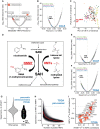Histone methyltransferase activity affects metabolism in human cells independently of transcriptional regulation
- PMID: 37883365
- PMCID: PMC10602318
- DOI: 10.1371/journal.pbio.3002354
Histone methyltransferase activity affects metabolism in human cells independently of transcriptional regulation
Abstract
The N-terminal tails of eukaryotic histones are frequently posttranslationally modified. The role of these modifications in transcriptional regulation is well-documented. However, the extent to which the enzymatic processes of histone posttranslational modification might affect metabolic regulation is less clear. Here, we investigated how histone methylation might affect metabolism using metabolomics, proteomics, and RNA-seq data from cancer cell lines, primary tumour samples and healthy tissue samples. In cancer, the expression of histone methyltransferases (HMTs) was inversely correlated to the activity of NNMT, an enzyme previously characterised as a methyl sink that disposes of excess methyl groups carried by the universal methyl donor S-adenosyl methionine (SAM or AdoMet). In healthy tissues, histone methylation was inversely correlated to the levels of an alternative methyl sink, PEMT. These associations affected the levels of multiple histone marks on chromatin genome-wide but had no detectable impact on transcriptional regulation. We show that HMTs with a variety of different associations to transcription are co-regulated by the Retinoblastoma (Rb) tumour suppressor in human cells. Rb-mutant cancers show increased total HMT activity and down-regulation of NNMT. Together, our results suggest that the total activity of HMTs affects SAM metabolism, independent of transcriptional regulation.
Copyright: © 2023 Perez, Sarkies. This is an open access article distributed under the terms of the Creative Commons Attribution License, which permits unrestricted use, distribution, and reproduction in any medium, provided the original author and source are credited.
Conflict of interest statement
The authors have declared that no competing interests exist.
Figures




Comment in
-
Metabolic sinkholes: Histones as methyl repositories.PLoS Biol. 2023 Oct 27;21(10):e3002371. doi: 10.1371/journal.pbio.3002371. eCollection 2023 Oct. PLoS Biol. 2023. PMID: 37889915 Free PMC article.
References
MeSH terms
Substances
LinkOut - more resources
Full Text Sources
Medical
Research Materials

